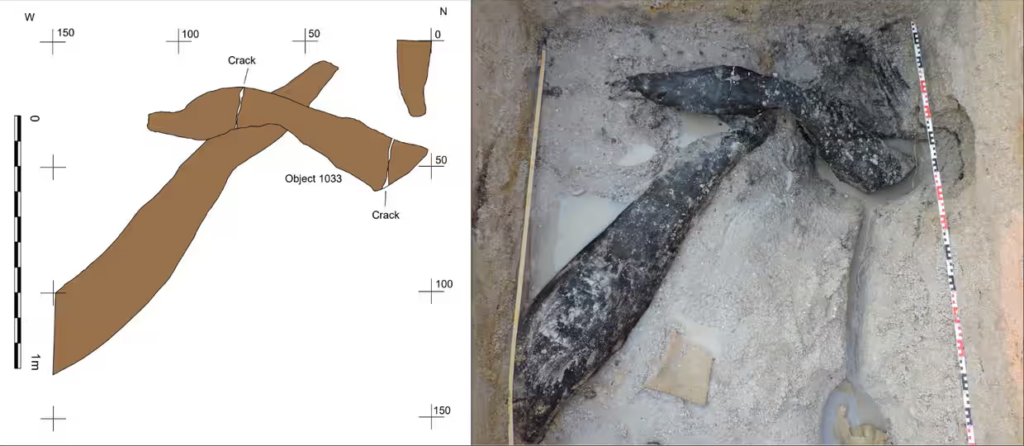On the banks of the Kalambo River in Zambia, a team of archaeologists have made a new discovery that reframes the way experts think about early hominid societies. The discovery in question are two wooden logs, overlapping at a right angle, and held together by a carved notch, and with additional markings believed to have been made by sharp, stone tools. This find is now possibly the oldest known wooden structure in the world, dated by experts at the University of Aberystwyth to 476,000 years ago. The site, a hard to access beach strip upstream of a 770 foot waterfall that flows into Lake Tanganyika, first hosted archaeological activity in 2006, that was later continued in 2019 by this team of archaeologists from universities and other organizations across the United Kingdom, Belgium, and Zambia. In addition to the remarkable wooden structure, the team also discovered more wooden artifacts, including a digging stick, a log cut on both ends, a wedge, and part of a trap. These finds were dated to around 390,000 years ago. This dates the artifacts as before homo sapiens, leading archeologists to speculate that these were created by an early human species, homo heidelbergensis (Sample 2023).

One of the factors that make this find so notable is the rarity of wood this old. In this case, these ancient wooden artifacts were preserved due to the waterlogged, oxygen-deprived sediment they were found in. The pieces were dated using a method called luminescence dating, as the finds were too ancient to be analyzed with radiocarbon dating or dendrochronology. Luminescence dating measures the energy of photons being released, and dates the last time the artifact was exposed to sunlight or extreme heat.

An additional factor in this artifact’s significance is what it reveals about ancient hominids. The fitted wood is theorized to have once been part of a larger structure, perhaps a walkway, raised platform for storing food, keeping fire off the wet ground, or a base for a house. No matter the purpose of the structure, the implication is the same: early hominids had the capacity to create plans for complex structures, and theoretically a language to communicate about these plans. Geoff Duller, a team member and co author of the study published about the find, remarked “It’s completely changed my view of what people were capable of that time” (Hunt 2023). This also calls into question the belief that early hominids were completely nomadic if they were creating structures such as this one. Furthermore, it also opens up the possibility that more structures like this existed, as the wood used to create them likely would not have survived. As of today, the artifacts are currently being conserved in the United Kingdom, but will be returned to Zambia for analysis. Finally, the archaeological team, along with the Zambian government are working to get the area acknowledged as a UNESCO World Heritage Site.
References:
Harris, Gareth. “World’s Oldest Wooden Structure Discovered in Zambia.” The Art Newspaper – International art news and events, September 21, 2023. https://www.theartnewspaper.com/2023/09/21/worlds-oldest-wooden-structure-discovered-in-zambia.
Hunt, Katie. “Archaeologists Unearth Oldest Known Wooden Structure in the World.” CNN, September 21, 2023. https://www.cnn.com/2023/09/20/africa/oldest-wooden-structure-zambia-scn/index.html.
“Luminescence Dating Laboratory.” Luminescence Dating Laboratory | U.S. Geological Survey. Accessed September 23, 2023. https://www.usgs.gov/labs/luminescence-dating-laboratory/luminescence-dating-laboratory.
Sample, Ian. “‘Oldest Wooden Structure’ Discovered on Border of Zambia and Tanzania.” The Guardian, September 20, 2023. https://www.theguardian.com/science/2023/sep/20/oldest-wooden-structure-discovered-on-border-of-zambia-and-tanzania.
Further Reading:
MUSONDA, FRANCIS B. “100 YEARS OF ARCHAEOLOGICAL RESEARCH IN ZAMBIA: CHANGING HISTORICAL PERSPECTIVES.” The South African Archaeological Bulletin 67, no. 195 (2012): 88–100. http://www.jstor.org/stable/23631395.
Barham, L., Duller, G.A.T., Candy, I. et al. Evidence for the earliest structural use of wood at least 476,000 years ago. Nature (2023). https://doi.org/10.1038/s41586-023-06557-9

You suggested that structures like this “call into question the belief that early hominids were completely nomadic” — How and why might this be the case? On another note, what are your thoughts on these artifacts being stored in the United Kingdom, rather than being studied where they were originally located?